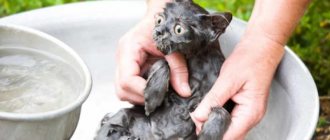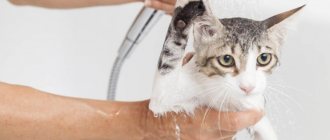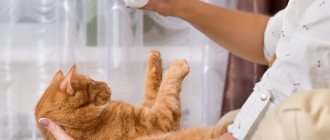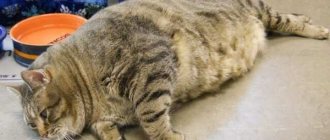How to accustom an animal to water?
It is important to get your kitten used to water from a very early age to avoid panic in the bathroom later on. To do this, you need to bring the animal into the bathroom more often, open the tap in front of it, so that the cat gets used to the sound of the water. You can let your pet walk in a dry bath to get used to this place. Then it will not cause panic or discomfort in the animal.
Important: the cat should not be fed immediately before bathing - the last meal should be 5-6 hours before the procedure.
If the animal begins to worry or become nervous, you need to give it time to calm down. There is no need to follow him, the owner himself should be completely calm. You need to behave with the animal extremely affectionately, do not frighten or speak loudly, so as not to cause panic in the pet. For overly pugnacious cats, there are special silicone claw attachments. They will prevent the animal from scratching while bathing.
How to wash a kitten if there is no special shampoo?
If there is no special shampoo, you can wash (if absolutely necessary) the cat with just water. It will perfectly wash away dirt without causing damage to the skin. Shampoos are also not suitable for other types of animals.
So, how often can you wash your kitten with shampoo? The less often you need to wash your pet, the better. Under any circumstances, this procedure can be repeated no more than once every 3-4 months, the best option is 2 times a year (as needed).
If we are talking about therapeutic bathing (for dermatitis, allergies, lichen), things are different: you need to wash the kitten as many times as the doctor prescribes.
Also an exception are exhibition animals - they are bathed immediately before the exhibition.
If you plan to take the animal to exhibitions, you need to accustom the kitten to water in advance so that in the future it experiences less stress. Some advise starting as early as a month, but it’s better to wait until two or three.
It is important to remember the following nuances:
- You cannot bathe a kitten for several days after vaccination. The British are bathed differently (like bathing a British kitten).
- 3 days before and 3 days after treatment for fleas (how to wash a kitten for fleas) and other parasites, you should also not bathe.
- It is best to wash a kitten when it adapts to its new place of residence - this is approximately 2-3 weeks.
The sequence of actions when bathing is as follows:
- It is important to comb the animal before bathing if it has long hair. Wet tangles cannot be untangled and can only be gotten rid of by cutting them off. If your kitten gets stressed while brushing, give him time to calm down before putting him in a bowl of water.
- You should not bathe the kitten immediately after eating - you need to wait 2-3 hours.
- You should fill the bath with warm water. If it is a kitten, a basin will be enough. The water should be slightly warmer than body temperature.
- The kitten will feel more confident if you put a towel on the bottom - the paws will not slide as much.
- The entire bathing procedure should take no more than 15 minutes.
- If the kitten is acting very restless, you can try to divert his attention to his toys: balls, rattles, mice.
- You should wash the kitten carefully so that the shampoo does not get into the ears, eyes, or nose.
- You should also be careful with water - if it gets into your ears, it can cause an inflammatory process (otitis media). To protect them, you can use cotton balls by simply pressing them lightly into your ears. You can also make something like a shower cap out of cellophane. If this makes the kitten panic more, you should do without them and just carefully monitor the ears.
- After the shampoo has been thoroughly rinsed, the kitten should be wrapped in a towel and kept warm until it dries.
- It is advisable to comb the kitten if it has long hair.
- Treat the kitten to something tasty to smooth out the impressions of the “torture” and develop pleasant associations in it.
Important! It is better not to get into your ears unless absolutely necessary - if it seems that they are dirty, that a lot of wax is being formed, it is better to contact a specialist without first doing anything on your own.
Excessive dirt in the ears may indicate problems with the ears, including a parasitic disease - otodectosis. This disease is caused by a microscopic mite and is often found in outdoor kittens. The diagnosis is confirmed by microscopy of earwax.
If a tick is detected there, appropriate treatment is prescribed, and the doctor will show and tell you how and with what to properly clean the cat’s ears, as well as what to treat. Once the kitten gets rid of the tick, regular cleaning can be stopped.
To avoid lacerations on your hands, you can trim your nails first. It is advisable to not perform this procedure right before bathing, as cats become very panicky during nail trimming.
If the panic from bathing is superimposed on the panic from trimming nails, we will not get anything good.
If the kitten is shivering for a very long time and it is clear that he is cold, you can dry him with a hairdryer (especially if the apartment is cold), but use only the cold air mode.
Important! If the kitten continues to perceive bathing procedures as an act of violence, you can get dry shampoo: this product is applied to dry fur and then simply combed out.
These simple nuances will make bathing safe for the kitten.
Start of the procedure
If the cat behaves aggressively when trying to take it to the bathroom, it is worth finding an assistant who can catch and hold the pet in time during the procedure. At this moment, the person who will be washing the animal should adjust the temperature of the water, controlling its pressure - you can draw it either into the bathtub or into a deep basin. Water that is too hot or cold can further frighten your cat and cause it to catch a cold or burn it. If water is collected in a basin, you need to leave a little water at the bottom of the bath so that all surfaces of the selected container are heated in the water bath.
It will be convenient to prepare 2 towels at once - the first will absorb all the water, and the second will allow you to blot the remaining liquid, partially drying the wool.
You can place a small towel or rubber mat on the bottom of the bathtub. The cat, standing on it, will not feel insecure on the slippery surface.
Having filled the bath with a little water (no more than up to the middle of the cat’s body), you should carefully begin to wet its paws - this way the cat will be able to understand that nothing dangerous is happening to him. There is no need to frighten the cat with a shower or washing from a tap - it is better to gently pour water from a jug or ladle. Don’t forget to hold the animal and make sure it doesn’t break free. Next you need to wet your back, stomach, and neck. It is not recommended to touch the head, especially the ears - the pet may catch a cold. To protect him from this, you can put small cotton swabs in his ears before bathing - this way the sound of pouring water will no longer seem so loud to the animal, and the risk of getting his ears wet will be reduced.
Bathing: sequence of actions
So, let's move on to how exactly a cat should be washed, regardless of its age:
- Lay an unnecessary soft towel at the bottom of the bathtub or washstand, trim the animal’s claws, and put rubber gloves on your hands;
- The wool should be wetted not with a stream of water, but with a wet sponge. It is acceptable to bathe an adult pet in a somewhat cool environment;
- As we have already said, in the absence of a special product, you can wash your cat with regular baby shampoo, which is applied with delicate and massaging movements. If we are talking about purebred or exhibition animals, then they require special care cosmetics;
- The resulting foam is combed out with a brush, then the fur is washed with warm water from a ladle or mug, and the pet itself is blotted twice with dry towels;
- Upon completion of the execution, be sure to treat the sufferer to his favorite delicacy.
Once again, we focus your attention on whether you can wash your cat with regular human shampoo. No, you should never do this; it’s better to use a baby product, but not one marked “2 in 1”. By the way, long-haired pets are allowed to be dried with a hairdryer after bathing, but at low temperature.
Shampoo or soap?
Despite the fact that washing a cat takes place at home, you must remember: ordinary shampoos and soaps are not suitable for its skin and fur. The fact is that humans and cats have different acid-base balances of the skin. This means that human hygiene products can cause allergies or other unpleasant diseases in your pet.
Today, the market for veterinary products offers a fairly wide range of different products for washing cats: shampoos, sprays, balms, dry shampoos, etc. It is enough to lightly lather the fur along the hair growth with a damp hand and rinse with water.
To protect yourself from scratches and bites if your cat is restless, you can wear oven mitts.
Dry shampoo is an indispensable solution for those whose cats are especially afraid of water and panic at the mere hint of going to the bathroom. The cat should be placed on the floor or table to make it easier to remove the powder from the fur. Then you need to sprinkle the animal with powder and comb it properly.
Is it possible to wash a kitten with regular shampoo?
So, is it possible to use regular shampoo? It is not advisable to use shampoos that we use ourselves (even for children) to bathe cats for several reasons:
- The structure of cats' skin is very different from ours.
- Their skin pH is higher.
- You need to wash your cat with a gentle shampoo that will not completely wash out their protective layer of skin. If it is completely washed, it will take a long time to recover, and the cat will be susceptible to hypothermia, colds, and infections for a long time.
- After bathing, the kitten must be kept warm. Small kittens () are especially at risk of catching a cold after washing.
Finishing the bath
After all manipulations with water are completed, you need to blot the cat with the first towel, then squeeze it a little and dry it with the second. If the noise from the hair dryer is tolerated by the animal, you can dry it a little. It is important not to bring the device too close, otherwise you can dry out the skin and coat. You should brush your cat so that after it dries there are no lumps and the coat looks well-groomed. Next, the animal must be placed in a warm place, from where it will get out on its own when it finally calms down. Temporary stress after bathing is considered normal and should not cause concern to owners. A tasty treat or affection from members of the household will help your pet come to its senses.
Cats love to drink running water and refuse stagnant water. Therefore, mustachioed creatures often jump on sinks, pushing their tongues under the taps. A cat can jump onto the bathtub and into it itself. However, a minority of animals do this. Most mustaches are afraid to swim. Hence the owners’ question: “ Is it possible to wash a cat?
, especially if she resists.”
Contraindications for swimming
In some cases, you cannot wash your cat:
- during rehabilitation after surgery. Typically, complete recovery takes about a month, but it all depends on the degree of intervention in the body and the pet’s health condition;
- late pregnancy. Washing can be very stressful for a cat and can even cause premature birth;
- within 2 weeks after vaccination. The cat’s immunity is weakened, and it is better to postpone washing;
- if the animal is sick, bathing can worsen its condition. Cancel water procedures and follow the veterinarian’s recommendations.
Is it possible to wash a cat
They are reputed to be clean people. Mustaches have rough tongues. Upon closer inspection, they are covered with bristles. When licking them, fallen hairs, particles of dirt, and fluff cling to them. B vitamins also accumulate on the animal’s fur coat. By licking dirt, cats get them too. Vitamins of the category support the mental health of the predator.
you wash your cat often
, she will lose a valuable resource. You will have to give your pet vitamin complexes containing group B compounds. Therefore, it is recommended to bathe animals only if they are heavily soiled.
Cats that love water can be washed more frequently. There are such people. There are especially many people who like to swim among animals who have been accustomed to this since childhood. Then you don’t have to worry about how to wash your cat.
.
Kittens consider water procedures a game. For an adult animal that has not known bathing, it becomes a stressful situation.
Bathing a mustachioed pet: is it necessary?
It is possible and necessary to bathe a cat, but it should not be done as often as the owners sometimes think. It is recommended to subject a mustachioed family member to water procedures only when necessary. The same applies to hairless cats.
In cats, the skin produces a special secretion that is responsible for local protection of the body (local skin immunity) and for the good condition of the coat (acts as a natural lubricant and care product). With frequent and unreasonable bathing, the secretion is washed off and does not have time to be produced in full, and this already negatively affects both the skin and coat.
How to properly wash a cat
So, it’s worth getting used to bathing from childhood. The reporting point is 3 weeks after the change of baby teeth. Until then, the animal’s body is too vulnerable.
My kitten is completely gone right away. They start with the paws. When washing them, you need to follow the rules that apply to full bathing:
- To avoid drafts, close windows.
- Prepare shampoo and towel.
- Remove unnecessary items from the bathtub.
- Adjust the pressure and temperature of the jet in advance. The indicator should be about 35 degrees.
- Place an extra towel on the bottom of the bathtub. The soft base under the paws calms the cats, unlike the slippery icing.
- Pour some water up to about the level of your pet's chest.
- Place eye drops into the animal's ears and eyes. This will help avoid the irritating effects of detergents.
- Cover your ears with additional cotton wool.
- Lower the cat into the bath, holding it by the scruff of the neck. This way the predator won't be able to scratch.
- Apply a little cleanser to your palms.
- Rub the cosmetics into your pet's fur using circular motions. In this case, it is advisable to speak kindly to the animal, calming it down.
- You can rinse with bath water, but it is better to use a medium-pressure shower. The flow is directed from the animal's head.
- Get the cat out of the bath.
- Dry with a towel.
- You can dry it naturally or with a hairdryer. The latter is used if the cat is not afraid of the device.
When washing long-haired animals, their coat is sort of squeezed out in foamy shampoo. You can't rub it. This leads to the formation of tangles.
The question is: should cats be washed?
entirely. The answer is only in case of flea infestation. All cats do not tolerate hair washing well. Many “give” their bodies to the procedures with pleasure, they even purr.
When asked if cats are washed
, there are alternative answers. Pet stores sell dry shampoos. They come in the form:
- first
- powders
- mousses
- foam
They do not require water to use. The components of the shampoo, like a sponge, absorb impurities. The remaining mixture is combed out.
With dry shampoo, like regular shampoo, wash the cat
may receive additional care:
If you wash your cat with soap
, you can harm her skin. The product contains alkali. It negatively affects the health of the integument and can lead to:
- to allergic reactions
- dryness
- dandruff formation
Dry washing is ideal for cats that are afraid of water and weakened. With a decrease in immunity, standard bathing will “undermine” the body’s defenses even more.
The middle option between regular and dry washing is wiping your pet with wet wipes. Propylene glycol holds water in them. This is a hygroscopic gel with a sweetish taste and characteristic aroma. The substance is not toxic.
Added to propylene glycol in wet wipes:
- Detergents.
- Caring plant extracts.
- To ensure that cats are satisfied with the product, they add harmless aromatic fragrances, for example, valerian extract.
There is no alcohol in the wipes, which is harmful to the fur and skin of cats. Products are produced for general use and specialized:
- for wiping skin folds
- for paw care
- intended for wiping the eyes, do not irritate the mucous membranes
- for teeth, with anti-calculus components
- designed for cleaning ears
- for cat intimate hygiene
There are also regular cat shampoos that are used in combination with water. However, they are not so ordinary. The acid-base balance of the product differs from that of cosmetics for humans. The pH of human skin is approximately 6. The cats' indicator is 3-3.5 units less.
Here is the answer to the question, is it possible to wash a cat with shampoo?
for people. It is better to do the opposite - clean a person’s hair with a product from a pet store. Cosmetics will be gentle on human hair and skin. If you buy your pet in some Pantin:
- The animal's skin will dry out.
- The predator's fur will become stiff.
- The cat's coat will lose its pomp and shine.
Talking about how often to wash your cat
, veterinarians advise bathing mustachioed dogs a maximum of once every 2 months. Considering the cleanliness of the animals, you can switch to the “once every 3-4 months” schedule. However, there are unscheduled washes. The scheme is violated:
Special soap for cats
, or shampoos, wipes, are used more often for long-haired animals. Short-haired dogs are washed less often. Mustaches do an excellent job of caring for short hairs themselves.
If you wash an animal more than once a month, even with special products, the health of the cat’s skin is impaired. At the same time, the complete absence of water procedures harms the predator only if the fur is matted. Under the tangles, the skin begins to swell and become inflamed. However, even here you need not so much washing as a haircut.
Let's end the article on a poetic note. Questions regarding cats arise because whiskers are loved by people. The owners are concerned about the well-being of their pets, so they find out information.
As proof of their love, people dedicated thousands of paintings, songs, and poems to cats. Of the latter, I remember the lines of Sergei Mikhalkov: -
“The gray titmice are happy:
Birds are freezing in the cold.
Snow fell, frost fell,
Cat washes its nose with snow
».
Every owner of a furry pet sooner or later begins to worry about the question of how to wash a cat. Doing this can be much more difficult than it might seem at first glance. And all because most cats are terrified of water. This reaction is inherent in their nature. But this is not a reason not to bathe your pet. You just need to choose the most pleasant way to wash your animal, which would cause him minimal discomfort.
How not to bathe a cat: tips
Tips for bathing a cat:
- It is necessary to adjust the water pressure in advance and prepare the bathroom. Be sure to close the door to the room when putting the cat in the bath. Before you start bathing, try to remove from the bathtub all objects that the animal could get caught on and jump out.
- Remove any unnecessary items to prevent your pet from dumping open bottles of shampoo in the bathroom or on the floor. Before carrying out the manipulations, it is necessary to close all the vents and windows in the apartment in order to avoid drafts and colds for the animal. If you did everything correctly, the cat will not catch a cold. Of course, it is best to accustom a kitten to water procedures from an early age.
- The first bath should be carried out after changing the animal's milk teeth. For the first bath, you need to fill the bath with just a little water so that it lightly covers the paws. This way the kitten can get used to the water. With each bath, the amount of water increases. Never use human shampoo or soap for bathing.
- This is due to the fact that they contain a huge amount of alkali, which dries out the cat's skin. In this way, the fatty membrane is washed away, which prevents skin damage. It becomes dry and may flake and itch. Thus, you will acquire another problem in the form of dermatitis.
Wet kitten
Preparation for water procedures
It is very important to properly prepare for bathing your pet. Before washing your cat, you should enlist the help of an assistant. Together, it will be easier to deal with an animal that tries to slip out of the owner’s hands, avoiding water procedures.
To begin with, it is recommended to cut your pet’s nails. This precaution will avoid scratches on the skin if he begins to behave aggressively or tries to escape from the bathroom. Washing a cat if he is afraid of water is really a problem. But it can be easily solved. Especially for such cases, pet stores sell mesh bags that allow you to fix the animal in the desired position. The cat will not be able to get out not only from it, but also from the bathtub or basin. Restriction in movement, as well as the inability to scratch, will allow a person to quickly cope with their main task.
It is recommended to place a mat on the bottom of the bathtub. Washing a cat at home, when it feels a reliable floor under its paws, is several times easier. In addition, the animal can slide around the bathroom. It is possible that your pet will try to scratch its surface with sharp claws. A placed rug will prevent him from doing this.
You need to prepare shampoos in advance and place them next to you. After all, the cat will definitely not allow the owner to leave her alone in the bathroom while she goes to get detergent. It is recommended to prepare all necessary accessories immediately.
Reasons why cats are afraid of water
As we know, seals love to bathe and swim; village animals generally dive and fish in local reservoirs. Then what's the matter?
Apparently, when a cat doesn’t see the point in bathing, it resists, but why? Because their fur and undercoat create temperature protection, and when wet, this protection disappears and the animal freezes.
Important! An interesting fact is that cats do not freeze when it is cold and they do not feel hot when it is hot - this is all their natural protection. Therefore, the feeling of hypothermia is simply unpleasant for cats; they even catch a cold. And when they decide to swim on their own, they seem to be psychologically prepared for these sensations.
The second argument is greater sensitivity to odors. Tails really don't like the scents of shampoos and conditioners. Therefore, when choosing what to wash your cat with, if there is no special shampoo or if there is one, make sure that the product does not smell, or smells, but not strongly.
Choosing bathing care products
There are several types of shampoos for cat care:
- Dry
. It has the appearance of powder. This product is recommended for use in cases where the pet cannot tolerate water. Dry shampoo will absorb dirt. All that remains is to comb it out of the wool with a comb. - Spray
. It is an alternative to dry shampoo. - Liquid
. This product is considered the most effective in removing dirt and unpleasant odors from cat fur. In addition, it has a low cost compared to the above analogues.
Of course, preference should be given to liquid shampoo. The pet owner decides which product to buy. The main thing is that the shampoo cleanses the coat well and makes it soft. Many experts advise purchasing products that are designed not only for regular washing, but also for fighting fleas.
Video material
Now it will definitely be much easier for you to wash your cat, even if there is no special shampoo. You will not harm your beloved pet and will give it a neat appearance, in which you will not feel any discomfort from its presence in your home.
Ways to wash a cat if he is afraid of water
A cat is not always afraid of water. Most of the time, noise scares her. In order not to expose your pet to stress once again, you should fill the bath with warm water in advance. It is allowed to shower the animal. The pressure should not be too strong so that it does not produce unnecessary noise that frightens the cat.
The animal should be placed in the bath. To calm a frightened cat, you should talk to him in a gentle voice. While holding it, you need to water it with warm water from the shower. After wetting the wool well, you can apply a little shampoo to it. Using gentle massaging movements, the care product is rubbed over the pet’s body. After soaping, carefully rinse off the shampoo. Care must be taken to ensure that water does not get into the animal’s eyes and ears. The wool should be rinsed until there is no soap left on it. This will require at least three to four procedures.
The hardest part is over. Now the matter remains small. The cat needs to be dried. Under no circumstances should a cat be allowed to walk around the house wet. This way she will quickly freeze and possibly get sick. Immediately you need to wrap the animal in a bath towel. You can cuddle him to warm him up. As soon as the first towel becomes too wet, you should replace it with a second one.
Many owners dry their cat with a hairdryer. You can do the same, but only if the pet is not afraid of such noise. Otherwise, he will constantly break out, not allowing the owner to take proper care of herself. Therefore, it is still preferable to dry the animal with towels.
The cat will be in a depressed mood for the next hour after washing. She will try to lick out the remaining water in the fur. You should not disturb your pet during this period of time. He needs to be allowed to be alone with himself, to come to his senses.
If the owner begins to regularly bathe her beloved cat, then over time he will get used to the water and will become more responsive to this procedure. However, the first baths will be a huge stress for both the animal and its owner.
Despite the fact that many representatives of the cat family are able to independently monitor the cleanliness of their fur, there is a need to wash them from time to time. For example, when a pet got dirty outside or was treated with flea and tick medications. Washing a cat at home is not as difficult as it might seem, the main thing is to follow the recommendations of felinologists.
Almost all cats are afraid of water, so we advise you to accustom your pet to water procedures from childhood. Veterinarians advise giving the first wash 2-3 weeks after the kitten has moved into the house, even if it has not yet gotten dirty.
How to wash your cat's eyes and ears
So, even the most capricious cat was washed, but during bathing we went around the eyes and ears, and they should also be clean.
The cat's eyes are wiped with a cotton swab dipped in clean boiled water or a weak solution of tea or chamomile. Movements should be light, no need to press or rub your eyes.
It's time for ears. There is no need to clean them unless they become dirty. However, after washing the cat, water could get into the ears. You need to wipe the outer part of the ear with a cotton swab, on which it is better to twist an additional layer of cotton wool. Use a clean stick or dip it in a drop of Vaseline oil.
What tools to use
To wash cats, you must use only special products that are suitable for the type and color of their coat.
Regular soap and hair shampoo that sits on the bathroom shelf are not suitable. They can cause irritation, dry skin, make the fur hard, dull, and sometimes cause hair loss.
There are several types of cat shampoos:
- Dry. Ideal for animals that are terrified of water. The owner only needs to apply the powder to the animal’s fur, and after a few minutes comb it out thoroughly. The result of the procedure is in no way inferior to the water one.
- Sprays. They appeared on the market relatively recently, but their benefits have already been appreciated by many pet owners. The product does not require rinsing, but has not only cleansing, but also antistatic properties, and also makes it easier to comb hair and gives it shine.
- Liquid. The choice of liquid shampoos is large. Some are excellent at fighting dirt, giving the coat softness and shine, while others help in the fight against fleas.
Which shampoo to choose?
The question of what to lather the fur with: regular shampoo or choose a special product for washing your cat at home is controversial. Artificially bred breeds have thin and delicate skin, often susceptible to allergies. Aggressive shampoo intended for humans, and even more so soap, can cause great harm. For example, cause eczema, dandruff, dryness and cracked skin.
To bathe a British or Scottish cat, you will have to pick up a special cleaning product from a veterinarian that will eliminate the unpleasant odor and add shine to the coat.
For babies, it is better to buy products for kittens that protect delicate skin from damage and do not irritate the mucous membranes. Old cats should be washed with hypoallergenic products that eliminate itching and flaking.
Washing with baby shampoo is undesirable even for domestic felines. But in rare cases, this rule can be neglected if nothing else is at hand.
How to properly wash a cat at home
Washing a cat requires patience and care from the owner. You can make the process easier and more effective if you prepare for it in advance and follow a few tips suggested below.
Preparation
At the very beginning, you need to choose a place to wash the cat. It is most convenient to do this in the bathroom or sink.
Before the procedure, you should immediately prepare everything you need (special shampoo, a couple of well-absorbing towels, a hairdryer) and remove anything that the cat can cling to (washcloths, different bottles, towels, etc.). Well, then proceed to the main stage, enlisting the help of someone from the household and not forgetting to close the door to the room.
the washing up
Place the cat in the bath, holding him so that he cannot scratch him, and wet him with the shower stream, avoiding getting water into his ears and head.
The optimal water temperature for washing is 30-35 degrees!
Now apply shampoo to the fur - first spread it over the back, then on the chest and belly, and then lather the paws and tail well. You can massage with your hands, but stores sell special brushes for washing, which will make the task easier. At the very end, lather your neck and head, since animals like this stage the least. Afterwards, the product should be washed off, again making sure that water does not get into the ears, and repeat the procedure.
Drying
Finally, the animal needs to be wrapped in a clean, dry towel and the fur lightly blotted. Do not rub to dry it as quickly as possible. Replace the wet towel with a dry one, wrap the cat well and hold it in your arms, thereby demonstrating your love and care. At this time, the animal will shake violently, but after a couple of minutes it will calm down and perhaps even fall asleep.
You can finally dry the wool with a hairdryer. However, most cats are terrified of its noise. If your pet is one of these, do not further traumatize his psyche. Wait for the fur to dry on its own, but just make sure that the room is at least 24 degrees and there are no drafts, otherwise the animal may get sick.
Video: how to properly bathe a cat at home
What's in the article:
In nature, it is very rare to find cats that really love to swim. There are also a small number of those who can endure such a procedure. Therefore, we decided to devote our article today on the Koshechka.ru website to how to wash a cat.
Why do you need to wash domestic cats?
As you know, cat owners usually wash their pets rarely, and many never at all. And this is really almost true.
Cats are animals who, moreover, are their own cleaners - this is in their DNA. Their tongue is equipped with stiff bristles that allow you to clean out absolutely any dirt on the fur. But domestic cats, in terms of their immune system, are far from street cats. What street cats receive in the form of hardening with any bacteria, infections, random food and various types of dirt is not familiar to domestic pets. This is why cats still need to be bathed, although not often.
Important! When seasonal molting occurs, whiskers wash themselves more actively, which leads to the accumulation of hair in the gastrointestinal tract, and washing the pet is what gets rid of this problem. Force majeure also happens, for example, a cat gets dirty with something that is very difficult to wash off, and then it is necessary to bathe it.
Fluffy pets do not always behave decently, and not entirely pleasant situations often arise. Even if you have not encountered them yet, in the future you may find useful information about:
- What to do if the cat is tearing up the sofa?
- How to prevent your cat from tearing up the wallpaper?
- How to make a scratching post for a cat?
The only question that arises is if you suddenly discover that there are no cat wash products - how to wash your cat if there is no special shampoo. Below in the text you will find the answer.
Are cats washed? And how often?
Every cat, even a domestic one, needs water treatments. If you are the happy owner of a long-haired cat, then it is enough to bathe her once every 2-3 months. If the cat has short fur, then once every six months will be enough.
This applies to regular water procedures. If you find that your pet has returned from the street very dirty
, then it’s worth making an exception and urgently putting her fur in order.
It is especially important to do this if there is an oil stain, soot or something similar on the animal’s fur. Otherwise, the cat will lick itself and may get poisoned. The same exception is washing paws
. Therefore, this can be done after every walk outside or as they become dirty.
When should you bathe a cat?
It is necessary to bathe a cat only if there are good reasons for doing so. Indications for washing your pet:
- More than 2-3 months have passed since the last bath, and the cat’s fur has become dull, darkened, and matted;
- the cat is very dirty, for example, rolled in the mud or covered in paint;
- If parasites are found in the fur, you need to immediately bathe the cat and then treat the “fur coat” with an antiparasitic agent. You should especially carefully examine cats that are often outdoors and can “catch” ticks and fleas;
- washing may be recommended by a veterinarian if a cat develops allergies, lichen, dermatitis and other skin-related diseases;
- if you find a kitten on the street and decide to take it into the house, then you cannot do without water procedures;
- In preparation for the exhibition, you will have to wash the cat with a special shampoo and give your pet a “styling.”
Getting ready to wash your cat correctly
Bathing is a difficult, troublesome and stressful task for both the owner and the animal. Therefore, the ideal option would be to train the animal from childhood.
to such procedures. If you get an adult animal, then you should approach the first bath thoroughly so that in the future the animal does not perceive bathing negatively.
If you have a very active animal, you can try giving it a sedative.
. Among the strong and fast-acting ones, you can try “Batch” (England) or “Feliway” (France). But it is better to start giving “Fospasim” or “Kot Bayun” a week before swimming, since these drugs have an accumulating effect and begin to act after a while. Also, you should not use valerian, as it has the opposite effect: the animal will become too active and anxious.
When you urgently need to wash your cat
Cats are capable of taking care of their own cleanliness. They lick their fur several times a day; this behavior is inherent in them by nature. However, there are times when a pet requires additional water treatments. Sometimes the animal needs to be washed urgently. Then the owner is faced with the question: “Is it possible to bathe a cat with regular shampoo?”
Urgent water procedures are necessary in the following cases:
- Pets are thoroughly washed before the exhibition. However, such situations rarely arise. Owners of purebred cats, as a rule, purchase in advance everything they need to prepare their pet for the event.
- If the animal's fur is very dirty and the pet cannot clean it on its own.
- If a toxic substance gets on your cat's fur, it needs to be removed immediately.
- Long-haired cat breeds require frequent washing during the shedding period. Otherwise, licking yourself can lead to hair getting into the stomach and indigestion.
- If the animal has parasites in its fur. But in this case, human shampoos will not help. Special veterinary products are required to remove fleas and ticks.
How to wash a cat: procedure for washing an animal
And now the site will tell you how to properly wash a cat at home. It is better to bathe in a large basin, placing a terry towel on its bottom. The water should be about forty degrees for both washing and rinsing. You can dilute cat shampoo in water in advance or apply it to a brush and lather with it. This kind of combing process will not only calm the animal, but will also give it a lot of pleasure. It is best to use liquid detergents. They are easier to apply and easier to wash off, because the cat is a small fan of long water procedures.
So, you will need one bowl of soapy water and one of clean water to wash the cat and rinse it off immediately. If you have a long-haired cat, you should comb it thoroughly before bathing so that fluff and fallen hairs do not interfere with washing it thoroughly. When washing an animal, pay special attention to the paws, chin and tail. They need to be washed more thoroughly than others. Lathered, washed, rinsed. It is advisable that the procedure last no more than ten minutes. At the same time, you can and should talk to the animal in a gentle, calm voice, but under no circumstances should you shout. For example, about how good it will smell after this and how clean it will be.
After you rinse the cat in clean water, wrap it in a dry towel and take it to the room. Place it in a warm, secluded place where the animal can dry out in peace. You should not “squeeze” the animal - you need to blot it or dry it with a towel. You can also use a hairdryer when drying, provided that the cat is not afraid of it. The hind legs and tail should be dried first, and then move on to the front legs and collar.
Drying the cat after washing
Contrary to what most people think, after washing a cat it is not at all necessary to dry it with a hairdryer or try to create greenhouse conditions for it. A healthy pet will dry out calmly at average room temperature. The only thing is that there should be no drafts in the room, otherwise the cat may catch a cold.
Do not forget that for many animals the bathing procedure is a real stress. Be gentle with your pet, talk to him and do not punish him in any way, because he is not capricious, but truly afraid. Teach your pets to bathe from an early age so that in the future they will be more relaxed about this procedure.
Soap or shampoo for people: are they suitable for cats?
You can use soap. In emergency situations, the use of this product is acceptable, but it is necessary to choose brands that do not emit a strong aroma. It is recommended to give preference to baby soap.
Regular shampoo is not the best solution. It is allowed to be used only once. At the same time, you need to try not to soap the animal too much. It is best to make a weak soap solution and treat your pet with it, then rinse immediately.
What happens if the animal is regularly washed with a non-special product?
The systematic use of shampoos that are unsuitable for cats leads to changes in the structure of the hairs, the activity of the fat glands is disrupted, and the condition of the skin deteriorates.
The development of allergies cannot be ruled out. Because of this, the immune system weakens. The pet becomes more susceptible to various diseases.
How to wash a cat when there is no special shampoo at hand?
If the cat is not very dirty, you can simply wipe its fur locally with a cloth moistened with warm water. But there are situations when a cat requires urgent bathing procedures, for example, it is heavily soiled in something, or its fur is contaminated with some kind of toxic substance (which is not advisable to lick off).
In this case, one of the acceptable solutions is to use shampoo or liquid soap for newborns, or children under 3 years of age, with a neutral pH level and a minimum content of artificial additives, dyes and fragrances.
You can also use hair detergents intended for adults, just choose the most gentle one. These can be so-called soft shampoos intended for dry and damaged hair (they are distinguished by a low pH level), as well as alkalis.
Cat breed
: yard.
Asks
: Basilisk the Beautiful.
The essence of the question
: how to bathe a cat if there is no shampoo?
Our cat ran outside in the morning, for the first time in 5 years. The cat is neutered, we were surprised ourselves. Came in the evening of the same day. We wanted to give him a bath yesterday, we don’t know where he was climbing. And we don’t even have cat shampoo. And there are no veterinarians nearby either.
Is it possible to bathe a cat with regular shampoo or soap?
Among many cat lovers, there is an opinion that pets should not be bathed, but sometimes there is an urgent need to wash the cat. And these are not only cases when it gets very dirty, but also, for example, preparation for an exhibition.
The following two tabs change content below.
I am a veterinarian in one of the clinics in the city of Gomel (Belarus). I myself am an experienced cat lover, I have two Don Sphynxes. I love these animals very much and they love me back. These are charming cats - Marfa and Petrovna.
It’s true that you shouldn’t bathe cats often. The optimal amount of water treatments for domestic cats that do not leave the apartment is 3-4 times a year. After each bath, the cat's fur should be wiped dry with a non-hard towel.
Cats should not be bathed often.
What products, besides special shampoo, can be used to wash cats?
Cats have very sensitive and delicate skin, and their acid-base balance is very different from human ones. That is why, if you decide to wash your pet with your regular shampoo, you should choose the mildest possible product.
The ideal option is a shampoo for children that does not contain substances that can lead to dry skin and coat.
The ideal option is shampoo for children.
An incorrectly selected cat wash product can result in such unpleasant consequences as:
- skin irritation;
- deterioration of coat condition. If the product is not chosen correctly, the cat's fur can become brittle and dull;
It is recommended to wash your cat with shampoo if you want to give its fur a beautiful and well-groomed appearance. If the animal just gets dirty, you can wash off the dirt with clean warm water.
. To do this, just wet a piece of soft cloth in water and thoroughly wipe your pet, paying special attention to contaminated areas.
There are situations in which bathing a cat can lead to dangerous consequences for its health. These include cases such as:
- old age of the animal
. Such cats and cats are more susceptible to stress than young individuals, and every bath can be a serious test for their nervous system; - the animal has recently undergone surgery
; - There is cold air in the apartment or constant drafts
. In this case, the pet may freeze after bathing in warm water.
In most cases, cats are able to keep themselves clean without water or shampoo. To prevent fur from accumulating in the furry pet’s stomach after active licking, owners should give it special vitamins that help remove fur naturally.
If you nevertheless decide to bathe your pet and use human shampoo for this, then thoroughly wash the animal’s fur. Otherwise, when licking itself after bathing, the animal may lick off the product that remains on the fur and become seriously poisoned.
Washing with regular shampoo can be practiced only in case of... If you plan to subject your cat to regular water treatments, it is better to purchase a special cat shampoo.
The importance of choosing the right detergent for your furry pet
If the shampoo is chosen incorrectly, it will negatively affect the condition of the cat's coat.
The hair will become brittle, dull, begin to get tangled, and form clumps. The skin condition may worsen. When using inappropriate products, the dermis becomes dry and there is a risk of dandruff.
It is important to take a responsible approach to choosing shampoo.
Your pet needs to be properly cared for to avoid problems with its fur and skin. Responsibility for the health of the animal lies with the person.
It is recommended to bathe cats only with special shampoos intended for pets. In emergency situations, other means may be used.
Baby soap and shampoo cause the least harm. They do not contain aggressive substances that can lead to the development of allergies and other negative changes.
It is best to make sure that zoo shampoo is always available. Frequent bathing is not recommended for cats, and one bottle will last for several years. Don't try to save money on a pet.
Such actions can lead to a deterioration in the health of the cat or kitten.
Previous Care: Tartar in cats: causes, effective remedies and methods for cleaning your pet’s teeth
How to treat a cat?
Nature has created the cat breed in such a way that they themselves try to maintain their cleanliness by constantly licking their fur and maintaining personal hygiene. However, there are many situations when it is extremely necessary to bathe an adult cat or a small kitten. One of these problems is the presence of a large number of fleas on an animal brought home.
A large number of chemical products have been created for animals to kill fleas, but most of them are very highly toxic drugs, and for a small kitten very harmful to health and life. Therefore, the best way to get rid of fleas is to bathe the kitten with a special anti-flea shampoo containing insecticides.
Such chemicals (permethrin, etofenprox, phenothrin, etc.) are designed specifically to combat parasites and harmful insects.
How to wash an animal
How to properly wash a cat with regular human shampoo? Is it possible to use undiluted detergent on wool? Even the most gentle baby shampoo must be diluted with water before use. It cannot be applied to wool undiluted.
You need to dissolve 1 tablespoon of baby shampoo in 1 liter of water. This composition is applied to the wool and cleans it of dirt. It is important to rinse off the foam very thoroughly. To do this, the wool is washed three times with clean water.
It is known that cats do not like the process of bathing. This is due to the fact that when the animal gets wet, it freezes. Therefore, immediately after washing, the animal must be dried and covered with a towel. You should not dry the fur with a hairdryer; its sound can greatly frighten your pet. The cat should dry naturally. Towels need to be changed when they get wet.
Insecticide shampoos
When purchasing flea shampoo in a store, you need to carefully read the label, production dates and guarantees of this chemical product. Also, instructions are always added to them, telling in detail about its composition and principles of action, for cats of what age it can be used.
You can bathe kittens with flea shampoo only with a special one designed specifically for feline babies, because in high concentrations the chemicals can have harmful effects. Lugovoi, Bars and other shampoos have proven themselves well.
In addition to the main elements, various oils, plant extracts and minerals are also added to the shampoo, which help improve the structure of the cat's hair and its shine, which has a beneficial effect on the skin.
Insecticidal shampoos have varying degrees of effect on parasites depending on the age and weight of the cat.
When asked how often you can wash your cat with flea shampoo, you can answer: “depending on the situation.” Frequently washing and treating an animal is only possible if there are a large number of fleas in the fur. It is also necessary to check the instructions for the purchased product, which indicate the minimum period for re-processing.
Useful video
Visually see how you can bathe a kitten with regular shampoo.
Today you found out how many times you can wash a kitten with shampoo and whether you can wash a kitten with baby shampoo and regular shampoo.
When a small kitten appears in the house, the first question is, does it have fleas? This is especially true for kittens brought from the street, which may have a countless number of these “residents”. You need to immediately wash the cat with flea shampoo, otherwise they will jump all over the apartment.
Shampoo substitutes for cats
If washing needs to be done immediately, and there is no special shampoo, you can use those products that are intended for children. They do not contain fragrances, surfactants or chemicals that can cause harm.
Products that meet the following requirements are considered suitable for pets:
- simple composition;
- absence of allergenic components;
- The smell is weak, neutral.
Preference should be given to shampoos intended for children under three years of age.
Such products act gently and as carefully as possible. With their help, it is possible to clean the fur and skin without causing harm to the animal.
Is it possible to wash a cat with baby soap?
If there are no special products for animals on hand, the use of baby soap is not prohibited, especially if it is a hypoallergenic product for the little ones. Shampoos for children are also acceptable, but it is important to remember that the phrase “does not cause tears” is nothing more than an advertising ploy.
When bathing your pet with baby products, take all precautions and be careful not to get soapy water and foam into your eyes, ears, or mouth. Do not overdo it when giving your animal water treatments with baby shampoos. Even the highest quality and most expensive baby soap can negatively affect the skin, causing rashes and allergies.
The widespread production and use of animal detergents is not a simple marketing ploy, but an urgent need. Don’t lose sight of the body’s individual reactions.
If you find it difficult to choose a shampoo or other product that helps bathe your pet, or you encounter allergic reactions and malaise after water treatments, contact the nearest veterinary clinic, you can call.
Qualified personnel will provide the necessary consultations and advice.
Is it possible to wash a cat with laundry soap?
Constantly is not possible. Laundry soap has a very hard and heavy structure for cat skin. After using it, dandruff is likely to appear. You may notice other allergic reactions.
It is acceptable to use laundry soap once, in extreme cases, when the animal needs to be bathed urgently, and there is nothing more suitable at hand.
Why can't you wash your cat with human shampoo?
The structure of skin and hair in humans and cats is very different. There are very few sweat and sebaceous glands on the surface of a cat's body. The skin reaction is 4.5–6 (as opposed to the human pH level of 3–4.5). The upper stratum corneum is thin and sensitive - such skin can easily be dried out with alkaline soap and irritated by artificial additives.
A cat's fur coat is a complex multi-level system that is involved in regulating the animal's body temperature. At the same time, its important element is the guard hairs, which, adjacent to each other, create a dense layer.
Violation of the hair cuticle with aggressive detergents leads to the fact that the hair becomes dull, disheveled, and tangles easily form in it. She cannot cope with her protective and thermoregulatory properties.
The difference between cat shampoos
In this regard, human and cat shampoos differ greatly in appearance and composition. For example, it is easy to see that cat detergents have different pH values.
In addition, cat shampoo should be completely rinsed off so as not to cause the risk of poisoning, since the cat will lick itself thoroughly after bathing. As a rule, such products do not contain strong-smelling fragrances so as not to irritate the animal’s sense of smell.
How to properly wash a cat: procedure
Now comes the hard part. How to quickly and painlessly wash a cat?
- Immerse the animal in water. Hold it with your left hand throughout the procedure.
- Douse your pet with water from a ladle or your hands to moisten the fur. We do not recommend using a shower hose or water tap - these noisy plumbing items can greatly frighten the cat.
- Pour some shampoo into your palms and lather.
- Gently apply the product to your pet, avoiding the area around the eyes and nose. Rub the shampoo into the fur and massage the cat's skin with light circular movements. Thoroughly rub the most contaminated areas: paws, top of the tail, belly, between the ears.
- Rinse off the shampoo with clean warm water. Make sure that there are no slippery areas of soap left on the fur, because the cat will lick itself after bathing.
- Wrap a clean pet in a terry towel and hold it in your arms. Let the natural fabric absorb excess moisture. After 2-3 minutes, release the cat so that he can clean himself up.
We invite you to familiarize yourself with a couple more useful tips on how to wash your cat correctly.
- Do not pour water on your pet's head - use a damp swab or soft washcloth.
- Make sure that water does not get into the cat's eyes, nose and ears (otherwise an inflammatory process may occur).
- Calm the animal with praise and kind words, do not make sudden or noisy movements, and take your time.
- Do not use a hairdryer to dry your pet's fur.
We recommend: How to remove scratches from watch glass? 3 best ways
Let's find out whether it is possible to wash cats with tar soap, laundry soap, children's soap, or regular soap?
Pets need care and attention, so sometimes owners have to force mustaches to undergo water procedures.
Cats are not bathed often. As usual, the need for this manifests itself in cases where the cat, or rather its fur, is heavily soiled or there are other indications, such as the presence of fleas, ticks, and other parasites.
For water procedures, choose specialized weakly alkaline products intended strictly for animals. You can purchase the usual liquid shampoos, gels, shampoo sprays, caring balms and even gentle “cat” soap at veterinary pharmacies.
It is not recommended to bathe animals with human shampoos and ordinary laundry soap. Cat and human skin have different acid-base balance - in cats the pH varies between three and three and a half, and in humans it reaches six.
Therefore, it is not recommended to use non-specialized shampoo for cats. This is fraught with the development of allergies, the appearance of dandruff, dry skin, loss of elasticity and shine of the coat, and its loss. This does not yet take into account individual reactions and possible intolerance.
- CAN YOU WASH YOUR CAT WITH REGULAR SOAP?
- CAN YOU WASH CATS WITH TAR SOAP?
- IS IT POSSIBLE TO WASH A CAT WITH LAUNDRY SOAP?
- IS IT POSSIBLE TO WASH A CAT WITH BABY SOAP?
- USEFUL VIDEO
Is it possible to wash cats with tar soap?
Tar soap, according to many breeders, is a real panacea in the fight against blood-sucking insects. Let's see if this is true. Any animal, even if it is completely domestic, has been infected with fleas at least once in its life, the larvae of which you could bring home on clothes and shoes. Pedigree cats, as well as show cats, are vaccinated against blood-sucking insects once every three months, and special notes are included in the veterinary passport.
Tar soap is a very primitive, cheap, but effective way to combat invasion. Thanks to the phenols, alkalis, citric acid and sodium salts it contains, soap repels insects. Benzene contained in birch tar has a paralytic effect on the nerve centers; alkali has an antiparasitic effect, burning through the shell of parasites.
In relation to insecticidal (antiparasitic) agents, soap with a tar component has a number of advantages:
- Absence of poisons, alkaloids of hazardous substances and heavy metals. Many modern parasite control products contain toxic substances, which is why they should be dosed and used with caution.
- It is allowed to use in the presence of wounds, abrasions, and other skin diseases.
- Tar soap can be used to treat animals against parasites as early as six to eight weeks of age, because it does not dry out the skin and maintains water balance. Even in human medicine it is prescribed as a prevention of skin diseases.
- The biggest danger of using tar soap is that its foam gets on the mucous membranes, as well as in the eyes and ears. Modern insecticidal preparations, when licked by animals, can cause severe forms of poisoning, paralysis and even death.
Disadvantages of using soap:
The larvae and eggs of parasites are insensitive to birch tar - it affects only mature adults. Bathing should be repeated two to three times every four to six days.
Washing a cat with tar soap is easy:
- Place the cat in the bath, wet its fur with warm (up to forty to forty-five degrees Celsius) water.
- Break off a piece of soap and lather until rich foam appears.
- Lather the wool using a bar of soap.
- Hold your pet for three to five minutes, even if he resists.
- Rinse off the foam with water and wrap the cat in a towel. Try to comb out fleas in the area of the ears and face.
- If your pet allows it, comb the fur a couple of times.
Many veterinarians believe that tar soap is a thing of the past, and modern shampoos can quickly and safely deal with parasites. They are not that expensive and are available to everyone.
Each owner must decide for himself what means to treat his pet in order to minimize risks.
Can I wash my cat with regular soap?
Yes, if you can choose a product with an optimal PH level and track the quality and nature of the other components listed in the composition. It is not recommended to bathe a cat with regular soap or human shampoo for the reasons listed above. Well-groomed hair is important for the cat family, so do not experiment, but use generally accepted and affordable shampoos located on the shelves of any veterinary store.











